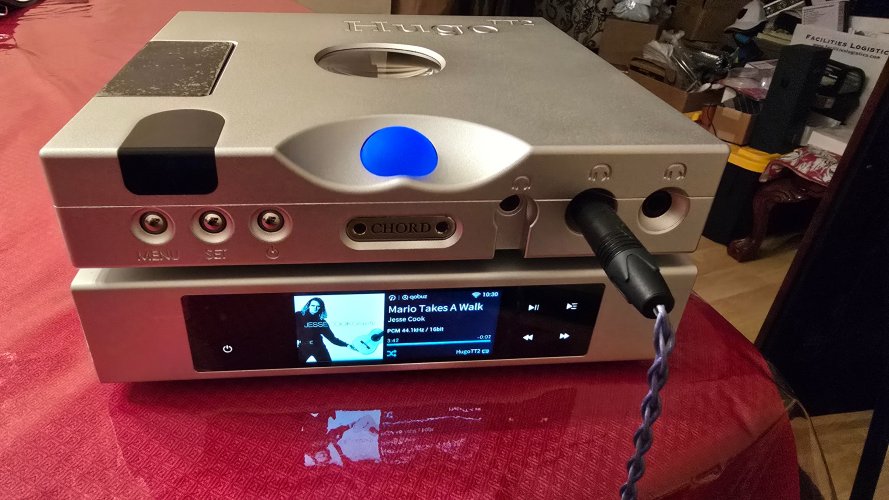JaZZ
Headphoneus Supremus
The supercaps are in the TT2. I wouldn't bother with another PSU as disconnecting the supplied PSU (for 10 seconds) produces no audible change. Linear PSUs generally do not have the RF filters built into SMPS and so normally sound brighter with the illusion of more transparency - but they are actually worse, and measure a lot worse due to lots more LF noise and magnetic noise, with higher leakage currents. The PSU I use has been selected, and measures identically to a battery supply using high bandwidth measurements.
Oh dear.
PSU noise at 55kHz is a completely meaningless specification for the M scaler. You could put HUGE levels of noise at this frequency and it will have NO effect whatsoever at the DAC side, due to the multistage regulation and filtering plus the OP galvanic isolation within the M scaler.
You have missed the most important point - capacitive coupling, and it's capacitive coupling that makes all the difference.
The M scaler has galvanic isolation on its OP but it has capacitive coupling of 2pF across the isolated domains. At 2GHz that is an impedance of 40 ohms; which means the isolation is not very effective, and there exists a path for current to potentially flow. And it's the current flowing into the DACs ground plane that is so important, as a current flow into the DAC ground-plane will create more noise floor modulation (brighter sound fooling people into thinking it is more transparent) and more correlated small signal errors (poorer perception of depth - giving the illusion of a wider and "better" soundstage).
I have spent many man months over several years researching this issue, and I fully understand the situation and how to take steps to ameliorate it; given the fixed and inescapable domain coupling capacitance, the problem is reduced via RF filters, which have course been embedded within the M scaler - to lengths that you wouldn't believe (even logic to logic coupling is treated). I spent a lot of time running SPICE simulations to improve the isolation - and this can be done via RF filters which constrains the current path within the local domain, thus breaking the current flowing into the DAC. But this approach is dependent upon parasitic capacitances which then dominate the effectiveness of this approach.
Given that I have done everything that is possible within the M scaler, how can the PSU help? Remember that the issue is current flow, and this only depends upon the loop impedance: mains>PSU>M scaler>Galvanic isolation on M scaler>BNC cables>DAC ground plane>DAC PSU>mains. You only need one of those steps to have high impedance at 2GHz and you are done; no current will flow and you will get no loss in SQ at all. And for readers that have not followed my previous posts it is the 2GHz range where we have the problem.
So how can we improve it with the PSU? You must use RF filters on the input side and the output side; RF filters reduces the coupling currents and helps; you should use a non grounded PSU - then the coupling is via neutral on the mains not earth - and to reduce coupling via the neutral you need a low inter-winding capacitance without using a grounded screen as this will increase the coupling capacitance. You get all these things with the supplied PSU - it has RF filter on the input and output, being a SMPS it uses a small transformer with low coupling capacitance and it is not grounded.
When you connect an "audiophile" linear PSU you will destroy all of these benefits - no RF filters at all, big screened toroidal transformers with huge capacitive inter-winding capacitance; so you will degrade the isolation at 2GHz, and increase the coupling currents into the DAC. You then get rewarded with a brighter SQ (conning you into thinking it's more transparent), a wider soundstage, an artificial etched quality and of course more listening fatigue - all due to more noise floor modulation and increased small signal amplitude errors.
Sorry if I am being a bit hard on you, but I do get very frustrated when I see audiophiles spend cash on "upgrades" that I know are damaging sound quality and more importantly the ability to enjoy music.
Keep safe and happy listening in these troubled times.
Certainly it's legitimate to doubt Rob's findings if you have good counter arguments (and I happen to disagree with him on one thing myself), but it's hard to believe others' interpretations of «better sound» if you have experienced numerous cases where objectively worse sound is interpreted as better. And in the case of Chord's SMPS Rob's explanation is hard to counter.























